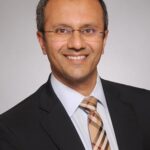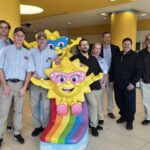.jpg) While wireless location tracking technology is not a new thing – shipping companies use it every day – its benefits have really not been explored in the healthcare industry. MedsMeet, a Florida-based company co-founded by Dr. Michael Zahalsky and Brandon Mabey, is hoping to change that.
While wireless location tracking technology is not a new thing – shipping companies use it every day – its benefits have really not been explored in the healthcare industry. MedsMeet, a Florida-based company co-founded by Dr. Michael Zahalsky and Brandon Mabey, is hoping to change that.
“In the last five years, Magic Band technology has been used in amusement parks and on cruise lines to provide information about population flow,” explained Dr. Zahalsky. “Our question was how do you implement this type of technology in a hospital setting? How do you utilize it in the medical field to improve efficiency and safety?”
MedsMeet is designed to provide wireless location services for tracking people, tools and equipment in hospitals and healthcare facilities.
“We have created a way to track surgical trays in and out of ovens, to and from surgical rooms, and in and out of storage rooms, so that when a doctor asks for a specific tray, they know where it is. This way, they always have the right surgical tools, which saves time,” said Mabey.
“When you have a beacon on every single significant tray or piece of operating room equipment, it can’t get lost or stolen,” added Dr. Zahalsky. “This technology wasn’t used before because RFID tags couldn’t be placed on trays cleaned in an autoclave, but we’ve solved that issue; we’re one of the only companies in the world offering auto-clave safe tracking technology.”
Mabey, who was previously in charge of developing, designing and deploying this same type of technology for Walt Disney World and different cruise ship lines, has redefined the hardware and software to specifically meet healthcare business models. In addition to using the technology to locate and protect equipment, it can also be utilized to keep patients safe, and to track staff workflow.
“This technology can track patients or guests who log into the hospital to make sure that they are on the right floor or are authorized to be in the section of the hospital that they’re visiting,” he explained. “It can also be used to determine if a patient has wandered from a room, or fallen in the bathroom so that staff can go check on them.”
Because the wristbands or necklaces that patients wear do not identify them by name but only by a number, patients’ identities are not compromised. “The patient tracking system has a unique identifier, so we don’t know who the patient is,” explained Mabey. “All we know is that hospital band #1 went into a room; only the hospital knows who #1 is. This helps ensure HIPAA compliance because patient data does not leave the hospital.”
Mabey believes that this technology could be of special importance in pediatric wards, where it is imperative to keep track of young patients. “You may have 40 kids checked in, and this way, you know where they all are,” he explained. “If the hospital doesn’t want them in certain areas, for example, near exit doors, an alert will be sent to nurses’ iPhones and desktops when a child is not where he or she is supposed to be.
“This not only mitigates risk, but can actually prevent a problem from happening,” he continued, adding that the technology can be customized to each hospital setting. For example, alerts can be sent to anyone within 100 feet of the exit door, or to staff members on the entire floor.
Dr. Zahalsky believes that the same technology that is used in Walt Disney World for population management – to help the company determine how to distribute people so that a specific park doesn’t get too crowded – can also be used to increase efficiencies in healthcare facilities. “From an administrative perspective, it could be used to see how long it takes for staff to perform certain tasks and to point out bottlenecks,” he explained.
“In the case of an emergency, it could let administrators know if everyone was out of the hospital; in an assisted living facility or rehab center, it could let staff know if a patient was left in a bathroom, or was in need of special assistance,” he continued.
“We’re all looking for efficiencies in healthcare, and while conceptually we knew that tracking technology existed, up until now it hasn’t been implemented,” he added. “We’ve figured out a way to do it.”

























